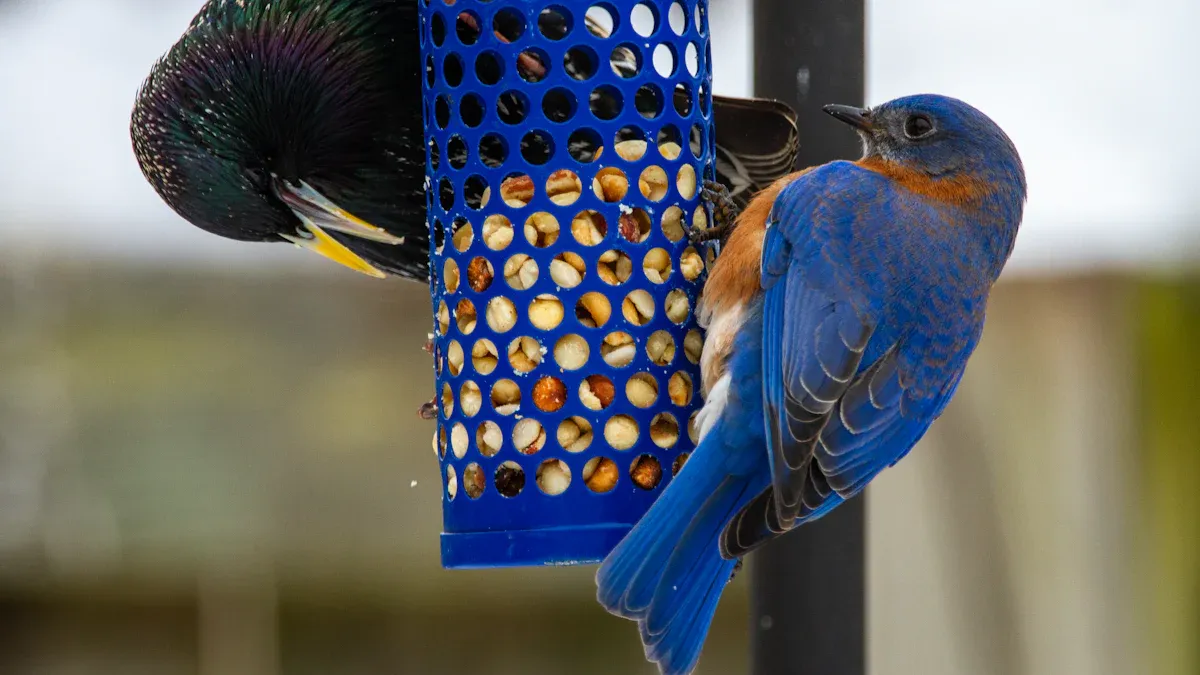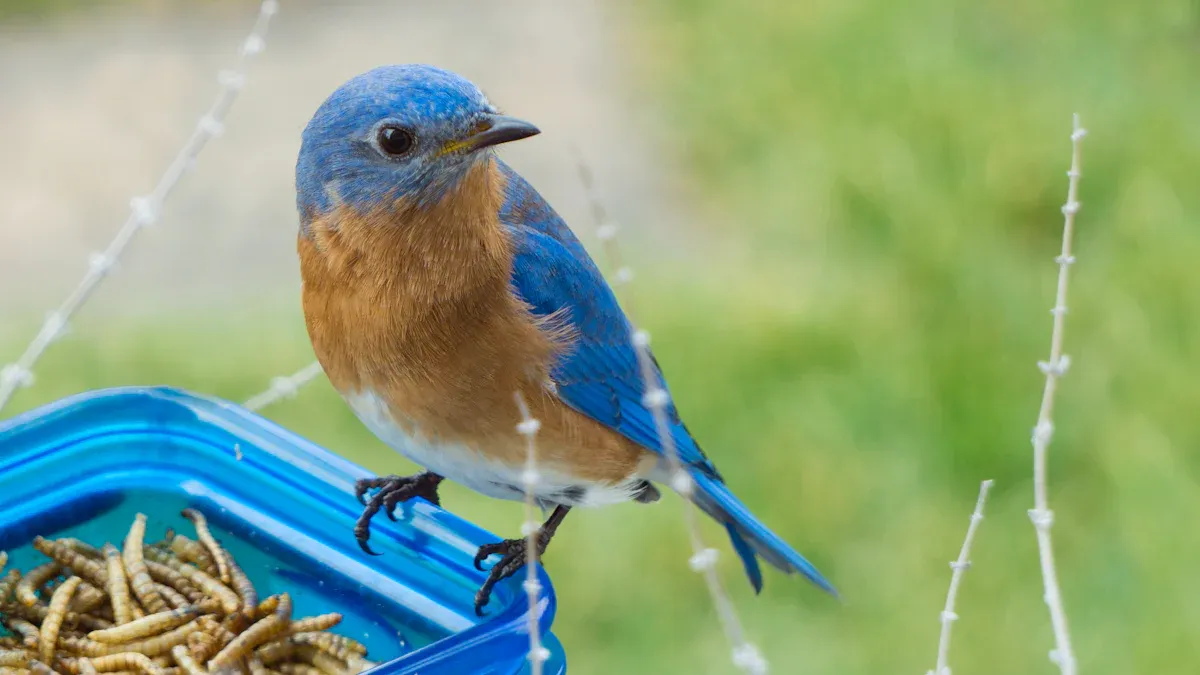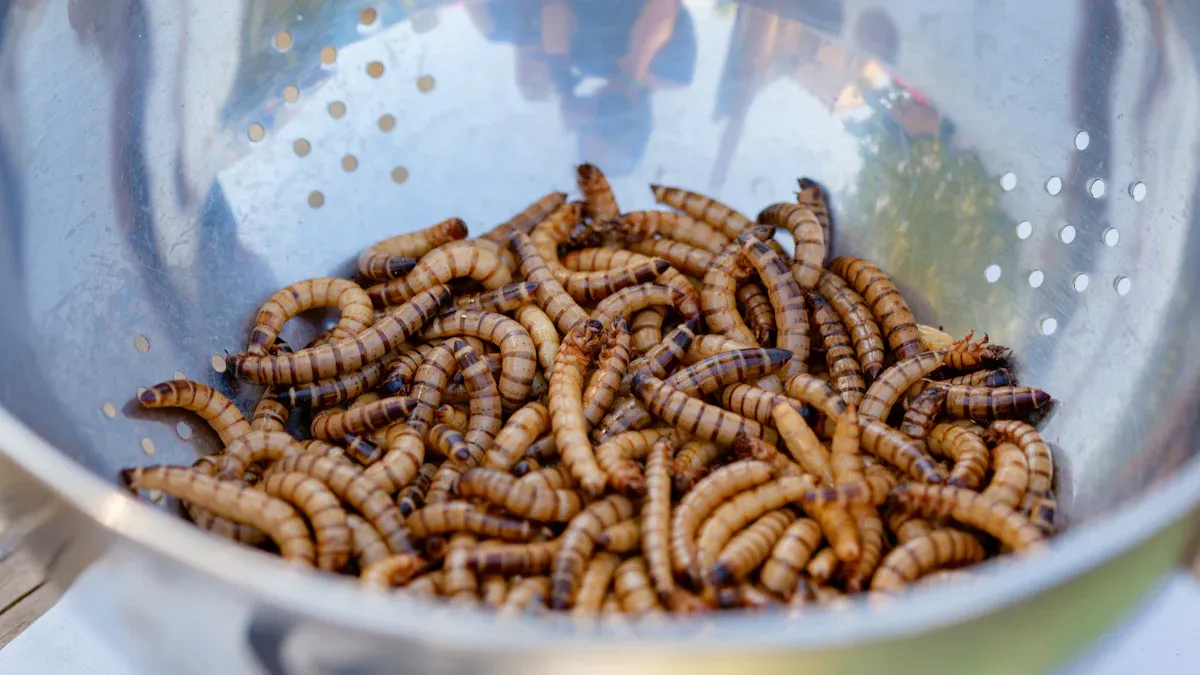
Feeding dried mealworms to birds is a simple way to support their health and attract them to your yard. Mealworms are rich in protein, which helps birds during critical life stages like laying eggs or feeding chicks. Since 80% of bird families eat insects, mealworms are a natural and ecological choice.
Did you know? Birds rely on high-protein foods like mealworms to grow feathers, prepare for nesting, and survive harsh winters.
Key Takeaways
- Dried mealworms are healthy for birds. They give protein, fat, and fiber, which help birds stay strong during important times in their lives.
- Feeding dried mealworms is easy and flexible. You can soak them to make eating simpler or mix them with other foods to bring different bird types.
- Feeding birds regularly helps them trust you. This makes them visit your yard often and gives you a fun birdwatching time.
Benefits of Feeding Dried Mealworms to Birds

Nutritional Value for Birds
Dried mealworms pack a powerful punch when it comes to nutrition. They are rich in protein, fat, and fiber, making them an excellent food source for birds. Protein helps birds grow strong feathers and supports their energy needs during nesting and migration. Fat provides a quick energy boost, especially in colder months. Here’s a quick comparison of the nutrients in dried and live mealworms:
| Nutrient | Dried Mealworms | Live Mealworms |
|---|---|---|
| Protein | 53% | 20% |
| Fat | 28% | 13% |
| Fiber | 6% | 2% |
This high nutritional value makes dried mealworms a favorite among many bird species. Whether it’s a chickadee preparing for winter or a bluebird feeding its young, mealworms provide the essential nutrients birds need to thrive.
Convenience and Versatility
Feeding dried mealworms to birds is not only beneficial for them but also convenient for bird enthusiasts. Unlike live mealworms, dried ones are easy to store and handle. They don’t require refrigeration or special care, making them an economical and hassle-free option.
Dried mealworms are also incredibly versatile. Bird lovers can soak them in lukewarm water to make them softer and more appealing. Mixing them with oatmeal or placing them on a hanging platform feeder can attract a variety of birds, from wrens to nuthatches. These flexible feeding methods make it easy to cater to different bird preferences.
Year-Round Feeding Option
One of the best things about dried mealworms is their suitability for year-round feeding. Birds need extra energy during winter, and mealworms provide the perfect high-fat snack. In spring and summer, they help birds during nesting and chick-rearing seasons. Even in fall, when birds prepare for migration, mealworms offer the protein boost they need.
By offering dried mealworms throughout the year, bird enthusiasts can support their feathered friends during every season. This consistent food source encourages birds to visit regularly, creating a lively and thriving backyard environment.
Birds That Love Dried Mealworms
Common Backyard Birds
Many common backyard birds enjoy feeding on dried mealworms. These include:
- Robins
- Bluebirds
- Blue Jays
- Sparrows
- Finches
- Cardinals
- Woodpeckers
- Nuthatches
- Titmice
- Wrens
- Chickadees
- Warblers
- Purple Martins
These birds are naturally drawn to mealworms because they mimic the insects found in their diets. Offering dried mealworms can attract a variety of species, making your yard a lively birdwatching spot.
Seasonal Visitors
Some birds only visit during specific seasons, but they also love dried mealworms. These seasonal visitors include:
- Bluebirds
- Chickadees
- Thrushes
- Titmice
- Wrens
- Nuthatches
- Kinglets
Providing mealworms during migration or nesting seasons can help these birds refuel and thrive.
How to Spot Mealworm-Eating Birds
Attracting and identifying mealworm-eating birds is easier with a few simple techniques:
- Use a backyard feeder filled with dried mealworms to draw bug-eating birds like bluebirds.
- Soak dried mealworms in lukewarm water to make them more appealing.
- Offer live mealworms initially to introduce birds to the food before switching to dried ones.
Birding experts Kenn and Kimberly Kaufman recommend starting with live mealworms to grab birds’ attention. Once they recognize the food source, dried mealworms become a convenient alternative.
By observing these behaviors and using these tips, bird enthusiasts can easily spot and enjoy the company of mealworm-eating birds.
How to Present Dried Mealworms

Soaking vs. Dry Mealworms
Birds enjoy dried mealworms in both their dry and soaked forms. Soaking mealworms in lukewarm water for about 10-15 minutes softens them, making them easier for birds to eat. This method is especially helpful during nesting seasons when birds need extra hydration. Soaked mealworms closely resemble live insects, which can make them more appealing to picky eaters.
Dry mealworms, on the other hand, are perfect for feeders that protect food from moisture. They are less messy and easier to store. Offering both options allows bird enthusiasts to cater to a wider variety of birds and their preferences.
Choosing the Right Feeder
The right feeder can make all the difference when feeding dried mealworms to birds. Look for feeders with these features:
- Tall sides to prevent mealworms from spilling out.
- A roof or baffle to shield the food from rain.
- Drainage holes to keep mealworms dry and fresh.
- Tamper-resistant designs to deter squirrels and other pests.
Platform feeders, mesh trays, or specialized mealworm feeders work well. Placing the feeder in a visible yet safe location encourages birds to visit regularly.
Mixing Mealworms with Other Foods
Combining dried mealworms with other bird foods can attract a wider variety of species. Here are some effective ways to mix them:
- Add mealworms to seed blends or suet cakes.
- Offer them alongside fruits like chopped apples or berries.
- Soak mealworms before mixing to make them more appealing.
A mixed diet provides birds with balanced nutrition. Mealworms supply protein and fat, while seeds and fruits add variety. This combination attracts birds like robins, bluebirds, and chickadees, even those that might not eat seeds alone.
| Benefit | 이름 * |
|---|---|
| Nutritional Value | Dried mealworms provide a balance of protein, fat, and fiber for bird health. |
| Appeal to Natural Instincts | Insects like mealworms are part of many songbirds’ natural diets. |
| Attracts Variety of Species | They can attract birds that are not interested in seeds alone. |
By experimenting with these methods, bird enthusiasts can create a feeding station that meets the needs of many species.
Storing Dried Mealworms Properly
Proper storage of dried mealworms ensures they stay fresh, pest-free, and ready to feed your feathered friends. Following a few simple steps can help maintain their quality and extend their shelf life.
Keeping Mealworms Fresh
To keep dried mealworms fresh, store them in a cool, dry place. Ideally, the temperature should range between 50°F and 60°F. This prevents spoilage and helps retain their nutritional value. Airtight containers work best for storage, as they block out moisture and contaminants. Adding bedding material like wheat bran or oatmeal can also help absorb any excess moisture.
For long-term freshness, rotate your stock regularly. Use the oldest mealworms first to avoid waste. Cleaning the container every few weeks also reduces the risk of mold or unpleasant odors.
팁: If you notice any dampness, place a paper towel inside the container to absorb moisture and keep the mealworms dry.
Preventing Pests and Moisture
Pests and moisture can ruin your supply of dried mealworms. To prevent this, store them in a sealed container with proper ventilation. Small holes in the lid allow airflow, which helps avoid condensation. Keep the container in a cool spot away from direct sunlight and humidity.
Adding bedding material like cornmeal or wheat bran not only absorbs moisture but also creates a barrier against pests. Regularly checking the container for signs of mold or insects ensures your mealworms remain safe for birds.
Shelf Life of Dried Mealworms
Dried mealworms have a long shelf life when stored correctly. However, high temperatures and humidity can shorten their lifespan. Heat speeds up degradation, while moisture can lead to spoilage. By maintaining a stable, cool environment, you can keep your mealworms fresh for months.
참고 : Always check for changes in color, smell, or texture. These signs may indicate that the mealworms are no longer suitable for feeding.
With proper storage, dried mealworms can remain a reliable and nutritious treat for your backyard birds.
Extra Tips for Attracting Birds
Creating a Bird-Friendly Space
A welcoming yard can make all the difference when attracting birds. Adding landscaping features that cater to their needs creates a safe and inviting environment. For example, feeders with tall sides prevent mealworms from spilling out, while a roof or rain guard keeps food dry during bad weather. Drainage holes in feeders help avoid water buildup, and tamper-resistant designs protect the food from pests like squirrels.
Planting native shrubs and trees also provides natural shelter and nesting spots. Birds feel safer in spaces with plenty of cover, so adding bushes or hedges near feeding areas can encourage them to visit more often.
Offering Water Alongside Mealworms
Birds need water just as much as food. A clean water source, like a birdbath or shallow dish, can complement feeding dried mealworms to birds. Place the water near the feeding station to make it convenient for them. Moving water, such as a small fountain or dripper, can attract even more birds by catching their attention.
In colder months, consider using a heated birdbath to prevent water from freezing. This ensures birds have access to hydration year-round.
Consistency in Feeding Habits
Consistency is key to building trust with birds. Regularly refilling feeders and keeping them clean encourages birds to return. Birds often remember reliable food sources, so maintaining a routine helps establish your yard as a dependable spot.
Try feeding dried mealworms to birds at the same time each day. Over time, birds may adjust their visits to match your schedule, creating a predictable and enjoyable birdwatching experience.
Feeding dried mealworms to birds is an easy way to attract a variety of species. Mealworms provide clean, nutrient-rich food that supports birds during winter and spring. Soaking them in water or briefly offering live mealworms can make them more appealing. Experiment with these methods and enjoy a lively, bird-filled yard year-round!
제품 정보
How often should dried mealworms be offered to birds?
Birds can enjoy dried mealworms daily. Offering them in small amounts ensures freshness and prevents waste. Adjust the quantity based on how quickly birds consume them.
Can dried mealworms attract unwanted pests?
Proper storage in airtight containers keeps pests away. Use tamper-resistant feeders to deter squirrels or other animals from accessing the mealworms.
Are dried mealworms safe for baby birds?
Yes, they are safe. Soaking dried mealworms in water softens them, making them easier for parent birds to feed their chicks during nesting seasons.


